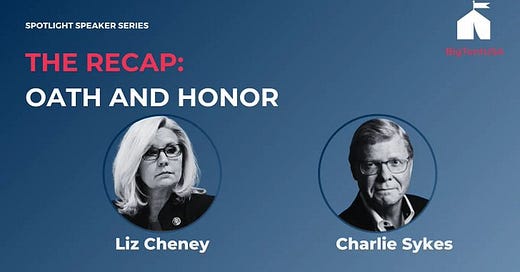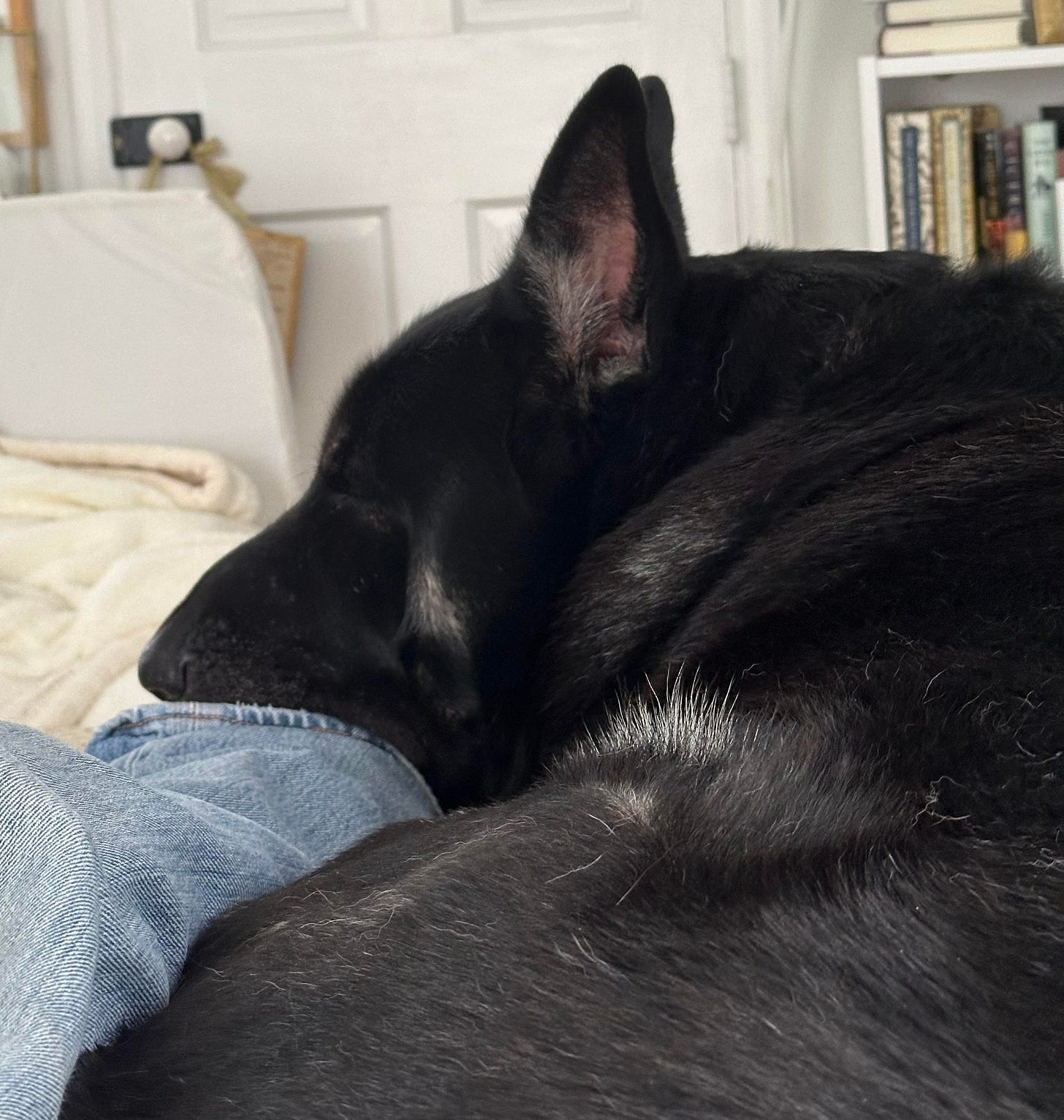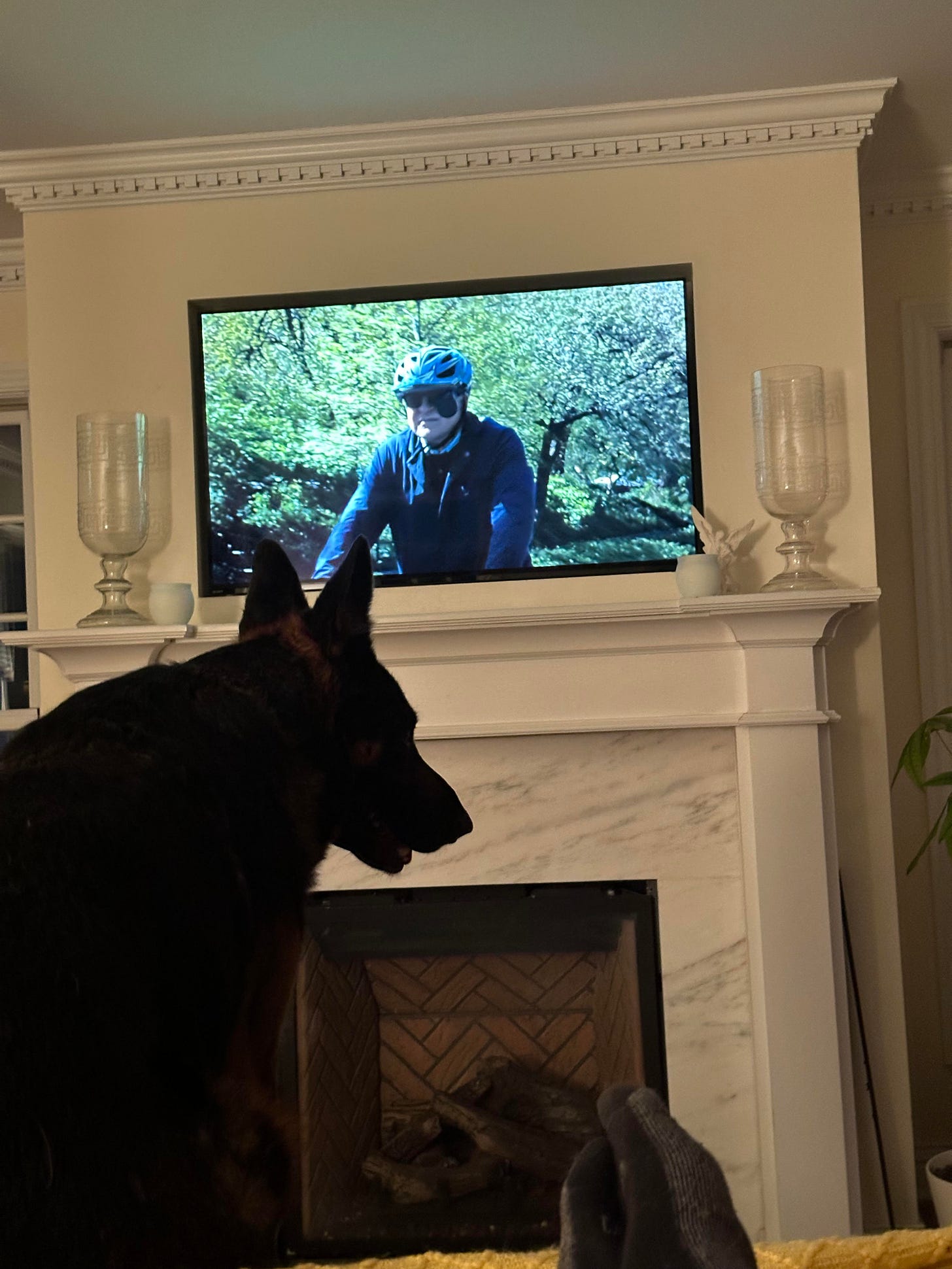ICYMI: I had a fascinating and bracing conversation with Liz Cheney the other night. Her message: “It’s uncomfortable for Republicans to be confronted with this reality that you have to choose between Donald Trump and the Constitution. You can’t support Donald Trump and the Constitution.”
You can listen to the podcast here. Or watch the video on YouTube.
Some obligatory dog pictures
Eli napping with his person.
Auggie watching the new documentary about Steve Martin.
The 1968 hangover
ICYMI, my latest piece for the Atlantic was a mixture of nostalgia and alarm. I remember 1968 vividly, because I was there (as a page at the Democratic National Convention in Chicago). Maybe that’s why I’m having flashbacks to what happened that year — and the way it ended. I readily concede that there are obvious differences: we have not (yet) had the kind of urban riots or assassinations that shadowed ‘68; we are not embroiled in an unpopular war, with images of Americans coming home in body-bags; and we don’t have a draft.
But 1968 still contains some cautionary notes, especially with the violent disruptions spreading across university campuses. The turmoil on college campuses and at the Democratic National Convention in 1968 helped propel Richard Nixon to victory—and marked a long-term transformation of national politics. Donald Trump obviously hopes that history will repeat itself.
The images of disorder on campuses and in the streets helped break the New Deal coalition apart and drive conservative and centrist voters away from the Democratic Party; they hastened the realignment of much of the American electorate. Republicans would hold the White House for 16 of the next 20 years. Indeed, the politics of the past six decades have been shaped by the divisions that sharpened that year. In 2024, we are still suffering from the hangover of 1968.
And a particular risk has emerged from the campus chaos of today: Even as the nation faces the clear and present danger of right-wing illiberalism, the next few months could be dominated by the far less existential threat of left-wing activists cosplaying their version of 1968. Tuesday night’s dramatic police action to clear an administration building at Columbia University that had been seized by anti-Israel activists took place 56 years to the day from one of the most violent clashes between police and protesters on that same campus. In 1968, activists occupied half a dozen university buildings during protests against the university’s affiliation with military research and its plans to build a segregated gym in a predominantly Black neighborhood. That occupation ended violently after New York police officers clashed with protesters and cleared the buildings. Hundreds of students were arrested, dozens injured, and an NYPD officer was left permanently disabled.
A “fact-finding commission” headed by the future Watergate special prosecutor Archibald Cox found that “the revolt enjoyed both wide and deep support among the students and junior faculty.” But the protests generated a backlash from the American public. The political fallout from 1968—a year that saw riots in cities, assassinations, campus upheavals, and the DNC riots—was immensely consequential. In 1968, both Nixon and Alabama Governor George Wallace (who was running as a third-party candidate) made the disorder in the streets and on campuses the centerpiece of their campaigns.
In November, the two men received a combined 56.2 percent of the popular vote—just four years after Lyndon Johnson’s Democratic landslide over Barry Goldwater.
But many campus activists, who were beginning the decades-long project of romanticizing 1968, felt emboldened….
What followed was obviously a turning point for both my father and for me. Neither of us voted for Nixon in 1972, but that year, despite the brewing Watergate scandal, he won reelection with 60.7 percent of the popular vote and 520 electoral votes.
In my book, “How the Right Lost Its Mind,” I wrote about the fallout from the campus protests.
My father was a World War II veteran, who opposed the Vietnam War because he regarded it as reckless and ill-advised, but he was also a deeply patriotic man, who understood what we were asking of the men and women in the military. He admired Eugene McCarthy’s courage in standing up for principle and challenging his own party’s incumbent president. I think that McCarthy, who wrote poetry and made no effort to tone down his wit or hide his erudition, was my father’s ideal politician and I shared his attitude. As a junior high school student he let me travel around the state with the Minnesota senator and his national press entourage, an experience that turned me into a political junkie, a condition from which I haven’t yet recovered.
But as the anti-war protests became more strident after Nixon’s election, my father became increasingly troubled by the tone of the movement. Opposition to a misguided war was morphing into a virulent anti-Americanism. My father, who had served in North Africa, Sicily, and Italy, was especially disgusted by the vicious treatment of returning Vietnam veterans; the first time I saw him truly angry was when he heard one activist celebrating a Viet Cong victory in a battle that cost more than a hundred American lives.
His disillusionment came to a head in 1970, when students went on strike after the invasion of Cambodia and sought to shut down the university where he taught. Originally launched to protest President Nixon’s decision to temporarily expand the Vietnam War into Cambodia, as my father later recalled, “The strike was quickly transformed into a crusade against an authoritarian and insensitive faculty, against irrelevant curricula, racism, sexism, oppression, capitalism, against American imperialism oppressing the revolutionary peoples of the Third World, and against all the assorted global inequities that the university has none of the means or the obligation to fix.” He described the scene on his campus:
“Bands of ragged students, heavily infiltrated by off-campus civilians and a few faculty partisans, roamed across the campus, through corridors, and into classrooms, chanting “on strike, shut it down.” Outfitted with simulated Che Guevara berets, Fidel Castro jackets, and arm bands, many appeared to be acting out roles in a grade-B adventure melodrama of a Balkan revolution. The guerilla brigades were later joined by truant high school students from nearby suburbs, attracted less by the cause than as a relief from boredom entered classrooms, demanding that the classes disband.”
After the shooting of four students at Kent State University, the strike intensified. Several university buildings were padlocked by the strikers who then stormed the university library demanding that it be shut down, threatening to scatter hundreds of thousands of book cataloging cards on the floor, which my father regarded as “a new version of book burning.” When strikers tried to shut down the student newspaper, my father, who was faculty advisor, ordered the occupiers to leave the office, he recalled, “upon which a seventeen-year-old Fidelista called me a ‘fascist pig.’” The paper was surrendered an hour later when it was discovered that “no one among the new barbarians had the expertise to operate a typewriter.”
For my father the climax of the strike came when he tried to drive through a blockade around the campus. A student protestor jumped on the hood of his car. “My response, not out of principle but personal anger, was to keep my car rolling forward, shouting at the student to get off my car.” The protest was no longer “an abstraction but a violent presence on my car. A potentially dangerous impasse was averted when one of the blockade leaders, remembering me from my affiliation with the McCarthy campaign two years before, told his colleagues to let me pass. ‘He’s all right,’ he said mistakenly. I still had some little credits which I quickly dissipated that week.”
Memories of the Sixties have been romanticized, but left-wing politics came to be dominated by humorless and strident ideologues, who did little to hide their contempt for the older generation, bourgeois values, and for American culture in general.
During the decade that followed, the excesses of the Left drove millions of former Democrats—families who had voted for Franklin Roosevelt, Harry Truman, and John F. Kennedy—to the right. The Left had seemingly lost its mind and the country seemed to be politically realigning, as were we.
**
And here we are again. From my Atlantic piece:
Like Nixon and Wallace before him, Trump (and the congressional GOP) will seize on the protests’ methodology and rhetoric—this time to further polarize an already deeply polarized electorate. The irony, of course, is rich: Even as Trump stands trial for multiple felonies, he is trying to cast himself as the candidate of law and order. Even as he lashes out about the campus protesters, he is pledging pardons for the rioters who attacked the Capitol.
But Trump would be right to think that every banner calling for “intifada,” every chant of “From the river to the sea,” every random protester who shouts “Death to America,” and every attempt to turn this year’s DNC into a repeat of 1968 brings him closer to a return to the Oval Office.
**
BONUS: Biden seems to get it. Via Susan Glasser in the New Yorker:
For now, Biden appears to have taken the advice that James Traub, the author of a timely new biography of Humphrey, offered in the Wall Street Journal this week. “The lesson of 1968,” Traub wrote, “is that while the fireworks are on the left, the votes are on the right.” Which is as good an explanation as any for why Biden, when he spoke to reporters on Thursday, in his most extensive comments to date on the escalating protests, sternly lectured that there was “not a right to cause chaos” along with the right to protest, rejected any suggestion that he change course in his Middle East policies, and dismissed Republican calls to bring in the National Guard to calm the campuses. The message was clear: this “moderate liberal in an age of extremism,” as Traub called him, is staying the course.
Nota Bene
Tom Nichols: A failure of imagination about Trump
People have a hard time imagining all of this is in part because Trump has a compliant, right-wing media ecosystem arrayed around him that tries to explain away his behavior. But it doesn’t help that others in the national media remain locked in the mindset that this is a normal election. Today, The New York Times ran an op-ed from Matthew Schmitz, a right-wing writer who assured readers that all will be well: “Mr. Trump may pose a threat to our political system as it now exists,” he writes, “but it is a threat animated by a democratic spirit.”…
Trump’s most alarmist opponents are wrong to insist that he would march into Washington in January 2025 like Hitler entering Paris. The process will be slower and more bureaucratic, starting with the seizure of the Justice Department and the Defense Department, two keys to controlling the nation. If Trump returns to office, he will not shoot democracy on Fifth Avenue. He and the people around him will paralyze it, limb by limb. The American public needs to get better at imagining what that would look like.
Mona Charen: The Gaza Protests are a Mirror Image of MAGA )
Columbia’s current crop of revolutionaries didn’t spring fully formed from the head of Zeus. They were nurtured in a warm, supportive environment that extends beyond the university. The lionization of activism, transgression, and revolution has been like a fault line, quiet most of the time but always there and capable of grave harm.
Consider the Columbia faculty’s response to students setting up an encampment in the middle of campus, refusing to disperse after multiple warnings, and disrupting other campus activities. The university senate met—not to admonish the students but to condemn the university president’s decision to call in the police. Worse, a number of faculty members rallied alongside the students. Shana Redmond, a professor of English and comparative literature, hailed the students with a megaphone, proclaiming, “We salute you, we stand with you, and we’re so proud to be your professors.”
Nellie Bowles: Not the art school debt, come on guys
Whenever we do an item about student debt relief, I have to delete my line about how they’re paying off underwater basket weaving classes. It’s too cliché. It’s been done. By me, but still. But then our Joe Biden goes and literally pays off underwater basket weaving class loans. Yes, this week he’s announced he is “forgiving” (i.e., taxpayers are providing the money for) debt for Art Institute students, who went to a literal scam school. Congratulations, taxpayers, you just paid $6.1 billion in student debt cancellation for 317,000 borrowers who chose art school. As an artist (this is my craft, TGIF is my Mona Lisa) I can tell you that the truly biggest scam in modern American intellectual life is telling young people they need a very expensive graduate degree to do things like paint or write. These are not skills that require higher order schooling! They barely require getting out of bed.
**








Charlie, when you were writing Morning Shots for The Bulwark and had warned about the rise of antisemitism on the campus left prior to 10/7 I had practically laughed it off in the comments section there—particularly when compared to the antisemitism that I had seen on the right for over a decade. I think it’s obvious that I had some blind spots that are now pretty visible. It’s too bad it took seeing college students waving Hamas flags and chanting Hamas slogans for me to wake up about that. Now I know what it must have felt like for you in 2015. You were right.
It worries me that the riots we have been seeing are very different in their fabric from those of the 60s. My Dad was also teaching on a college campus at the time. It was frightening. I wore a POW bracelet—hope against hope that the missing would be returned to us. As has been noted by others before me, US troops were dying in what was an impossible war. We didn’t know how to handle guerilla warfare. But there we were. The protests were heartfelt about people’s lives on the line. Later we would find out about draft dodgers and the impact on the makeup of the troops. I can never think it right to avoid a bad situation by placing someone else literally in the crosshairs.
The current conflict is deeply troubling. I always thought the Mossad were able to take out enemies with precision strikes. So why are tens of thousands of Gazan civilians dead? I don’t for a minute underestimate the absolute horror—beyond my imaginings of the Hamas attack. It was purposefully brutal, and targeted civilians including innocent children. The whole thing is absolutely awful. I wish Israel would consider its response. Starving out a whole country may feel like an eye for an eye, but is that a good thing? As to the protesters, I believe Mayor Adams was correct in saying that a lot of those protesting most vigorously and violently were not students. They were national organizers looking for the main chance. This is not to suggest that the students didn’t feel very strongly about the issue. But perhaps things would not have gotten out of hand if the students had been left alone. Add to that the magnification of a group event by social media, and you are headed for disaster.
It is a complex and heartbreaking situation now, but Vietnam hit us all hard. I think ‘68 was worse.